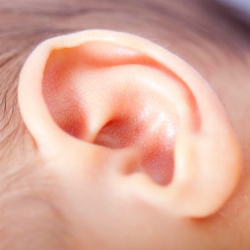Never too young for a hearing test

There are many reasons why children should be screened for hearing impairment, such as congenital hearing loss (newborns), recurrent ear infections in babies, and language delays in children. Conducting hearing tests in the above groups of children is one of the main challenges facing pediatric audiologists, and it’s no easy task! Fortunately, audiologists have a number of tools for diagnosing hearing problems in children, from birth through the various stages of development. Hearing tests typically fall into two main categories:
- Objective tests: do not require the child’s active participation and are often done while the child is sleeping.
- Subjective tests: require the child to participate in the evaluation, and usually involve some form of play.
Objective tests A range of objective tests are used to assess the functioning of different parts of the ear:
- Tympanometry, a test that takes only a few seconds, measures the mobility of the eardrum (tympanic membrane) and conduction bones (ossicles). All children undergo this examination, since ear infections are very common and can lead to clogging of the ear canal.
- Otoacoustic Emissions (OAEs) testing examines the function of the cochlea, the organ of hearing, by measuring the inaudible echo of sound that is reflected back from the inner ear in response to a sound stimulus. This test requires the child to remain still for a few minutes.
- The Auditory Brainstem Response (ABR) test, which can only be done if the child is sleeping or sedated, measures the function of the entire auditory system and the brain’s response to sound. While somewhat longer to perform, the test is particularly helpful to audiologists since it provides an accurate assessment of hearing sensitivity.
It is important to remember that all these tests can be performed from birth. They can also be very useful for testing specific regions of the ear in older children.
Subjective tests As of age one, children are old enough to undergo subjective testing (concurrently with the above-mentioned objective tests). Once the audiologist has gained the child’s trust, the tests—many of which consist in observing the child while he/she plays—are usually a fun experience.
- The child is first trained to perform a certain task each time a sound is heard (i.e. turn towards a stuffed animal that lights up, stack rings to make a tower or add the next puzzle piece). This is called visual reinforcement audiometry (VRA) or conditioned play audiometry. Then, the child is simply observed to monitor whether or not the required task is being done on cue.
- Depending on the child’s level of language, there are other activities that can be used, such as pointing to various parts of the face or an image, or repeating certain words.
- Headphones or loudspeakers are used to convey the audio cues (i.e. sounds, voice, music) during the test.
Audiologists have a wide array of objective tools and a bag full of tricks to get children of all ages to participate, regardless of their temperament (i.e. shy, scared, hyperactive). Therefore, remember that it is never too late to get your child’s hearing tested. Talk to your doctor about screening options, especially if you suspect a hearing problem.


